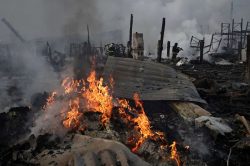11:49 JST, June 30, 2022
NARAYANGANJ, Bangladesh (Thomson Reuters Foundation) — As pale fumes billowed from a factory in the Bandar neighborhood of Narayanganj, clouding the afternoon sky, tea-stall owner Riad, 21, explained how dust and other pollution from local industries is harming crops and residents’ wellbeing.
“People here suffer from respiratory and health problems,” he said. “At night, noise and shaking caused by the local power plant disturb people’s sleep.”
Narayanganj city — a major industrial hub just to the south of Dhaka that produces most of the country’s knitwear exports — has the third-worst air quality in Bangladesh, according to a survey last year by Stamford University.
Manufacturing and construction, meanwhile, account for 58% of the city’s planet-warming emissions, showed an assessment by the South Asia branch of ICLEI — Local Governments for Sustainability, an international body that helps cities with green policies.
Major sources of pollution include the city’s seven cement factories, 70 to 80 illegal brick kilns and a number of steel mills, said Moinul Islam, town planner for Narayanganj City Corporation.
Narayanganj Mayor Salina Hayat Ivy, the first woman to head a city corporation in Bangladesh, told the Thomson Reuters Foundation she had asked cement and lime factories to relocate away from residential neighborhoods.
In April, the city corporation approved an action plan for low-carbon, climate-resilient development, supported by ICLEI, making Narayanganj the first Bangladeshi city to adopt such a plan, said Jubaer Rashid, Bangladesh representative for ICLEI South Asia.
“We assessed the vulnerability of the climate-impacted urban systems like energy, water supply, waste management and so on, and came up with realistic recommendations for the city to implement,” he said.
The city administration has already set up air-quality monitoring systems with help from ICLEI to detect and measure polluting gases like carbon monoxide, nitrogen dioxide and sulphur dioxide, as well as particulate matter, with real-time data displayed on public screens.
ICLEI has also encouraged renewable energy adoption in the city and has set up rooftop solar power systems at some public facilities including a public library and a hospital.
But cities have limited authority over policies and actions to tackle climate change in Bangladesh, where central government agencies are charged with delivering public services nationwide.
Municipalities need backing from the central government to roll out their plans, said Rafiur Rabbi, leader of the Citizens’ Committee, a local movement working on social and environmental issues.
The Department of Environment, for instance, enforces regulations on emissions and effluent management, while district deputy commissioners allocate land to factories.
Water works
Narayanganj industrialized rapidly in the last 100 years owing to its strategic location on the 113 kilometer-long Shitalakhya River, which meets the Dhaleshwari River near the city, according to local journalist Golam Rabbani.
Jute, hosiery and garment industries developed in the city as the goods could be transported along the Shitalakhya.
In addition, Narayanganj has more than two dozen canals for water transport and stormwater drainage to prevent flooding.
But in recent decades, there has been sustained encroachment on the river and canals, hampering run-off of stormwater and causing water-logging in some areas, said activist Rabbi.
The city corporation has been working to restore 26 canals in phases, which is expected to stop bad odors, boost vegetation and enable inhabitants to get around more easily.
“Water bodies also reduce the heat island effects in urban areas through evaporation,” said environmental engineer Dipak Bhowmick, ICLEI’s project officer in Narayanganj.
The Shitalakhya, however, has been damaged by dumping of untreated industrial effluents and municipal waste in its water, decimating biodiversity and making it “biologically almost dead,” said journalist Rabbani.
This has hurt local people too. Manoranjan Goswami, 73, a leader of the fisher community in eastern Narayanganj, lamented the loss of fish and erosion of traditional livelihoods.
“There are around 100 fisherman families here, but the fish stock in the river is mostly gone,” he said.
Smaller businesses usually lack funding to install and operate effluent treatment plants, said activist Rabbi, urging the government to set up central treatment plants to serve industry clusters.
The city corporation is working to build eco-parks — ecological zones including forests, wetlands and recreational green spaces — along the banks of the main river and canals to protect water bodies and address climate change, said Mayor Ivy.
Reducing river and canal pollution could also help ease growing pressure on underground aquifers as residents sink tube wells to extract clean water for their own use, she added.
Migrants overlooked
Mohammad Babul Hossain, 60, moved to the city from Chandpur several years ago, and has worked as a taxi and rickshaw driver in Narayanganj — a place he prefers as “there is too much hurly-burly and trouble over there in Dhaka.”
At least three-quarters of Narayanganj’s roughly 2.5 million-strong population are migrants from across Bangladesh.
As one of the most vulnerable countries to climate change, Bangladesh could see its internal climate migrants top 13 million by 2050, according to a 2018 World Bank report.
Boatmen like Mansur Gazi, 48, and Mahadeb, 45, who also left their flood-prone riverine district of Chandpur for Narayanganj, ferry people across the Shitalakhya for a few cents a journey.
Most of the manual and electric rickshaws that serve as popular transport in the city are also driven by migrants.
But their presence can cause social tensions, as “newcomers often settle down as roadside hawkers, causing congestion,” noted Rabbi.
Despite growing migration, Narayanganj — like the vast majority of cities — lacks a formal strategy to deal with the challenges, while migration as a way of adapting to climate change pressures is not included in its ICLEI-backed climate action plan.
Funding shortfall
Insufficient finance is the key constraint to Narayanganj’s efforts to pursue a climate-smart development model, said Mayor Ivy.
The city corporation’s annual budget for 2021-22 is about $80 million, while in Rajshahi — which has less than half the population but is the main city of its administrative division northwest of Dhaka — it is more than $120 million.
“We need a larger budget,” said Ivy, noting Narayanganj’s outsized contribution to the national economy.
ICLEI is working closely with the city corporation to formulate project proposals that include climate concerns and pitch them to global development organizations for funding, said ICLEI South Asia project officer Bhowmick.
The World Bank, Japanese government and Asian Development Bank are among those that have funded projects in the city.
Town planner Islam urged other government organizations working there, such as the Department of Environment and the Bangladesh Inland Water Transport Authority, to coordinate their activities with the city’s sustainable development aims.
ICLEI country head Rashid said Narayanganj would serve as a pilot for low-emissions urban development in Bangladesh. Rajshahi is the second city to approve and start implementing a climate action plan, but there are no others as yet, he noted.
The southwestern port city of Mongla, meanwhile, has made some progress, with Bangladeshi organizations helping it craft a strategy for infrastructure to prevent flooding, as well as opportunities for climate migrants.
“The example of Narayanganj will demonstrate how local governments could play a role in realizing the goals of the Paris Agreement on climate change,” Rashid said.
"News Services" POPULAR ARTICLE
-

American Playwright Jeremy O. Harris Arrested in Japan on Alleged Drug Smuggling
-

Japan’s Nikkei Stock Average as JGB Yields, Yen Rise on Rate-Hike Bets
-

Japan’s Nikkei Stock Average Licks Wounds after Selloff Sparked by BOJ Hike Bets (UPDATE 1)
-

Japanese Bond Yields Zoom, Stocks Slide as Rate Hike Looms
-

Japan’s Nikkei Stock Average Buoyed by Stable Yen; SoftBank’s Slide Caps Gains (UPDATE 1)
JN ACCESS RANKING
-

Keidanren Chairman Yoshinobu Tsutsui Visits Kashiwazaki-Kariwa Nuclear Power Plant; Inspects New Emergency Safety System
-

Imports of Rare Earths from China Facing Delays, May Be Caused by Deterioration of Japan-China Relations
-

University of Tokyo Professor Discusses Japanese Economic Security in Interview Ahead of Forum
-

Japan Pulls out of Vietnam Nuclear Project, Complicating Hanoi’s Power Plans
-

Govt Aims to Expand NISA Program Lineup, Abolish Age Restriction

























